White beauties across the North Atlantic
Before Scandinavian pioneer company SAS whisked away passengers into their pressurized jet cabins on polar routes and across the Atlantic, Swedes were traveling in record numbers back and forth across the ocean in the White Ships of the Swedish America Line.
-
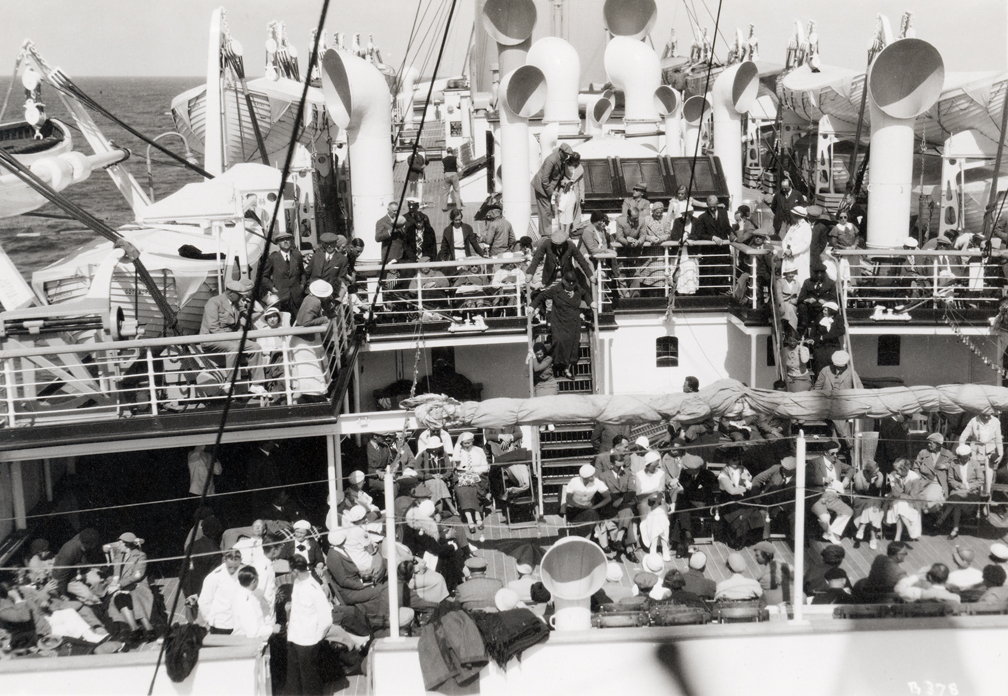 The upper decks were crowded on beautiful days ...
The upper decks were crowded on beautiful days ... -
-
The "White Ships” of Swedish America Line (SAL) are indelibly linked with the years of mass immigrations from Sweden to America. Tales from the ships' 1916-1975 era are far more than sentimental recollections — they also reveal that the glamour of ocean travel was tempered by the dangers of the mighty North Atlantic.
For three generations, the White Ships, proudly displaying the nation’s three golden crowns on their funnels, were the maritime pride of Sweden. While other ships provided tolerable accommodations only for first-class passengers, the White Ships established respectable standards for tourist-class travel as well. Their elegance and seaworthiness and the high level of service lavished on Swedish passengers bound for America made them immensely popular with Europe-bound Americans and Canadians as well.
Over the course of half a century, hundreds of thousands of Swedes arrived on White Ships as immigrants in New York. For many immigrants and their families, the White Ships were also the conduit for their first visit back to their ancestral homeland since arriving in America. For many of them, the crossing represented a deeply spiritual experience.
But the trips were also hair-raising, perilous and, tragically, not without fatalities. In the early years of Swedish emigration, most Swedish passengers were farm families, from infants to the elderly. Few had ever seen the ocean, much less been tossed about like unleashed cargo in wooden ships on the North Atlantic. Swedish Church records documented those departing, and the ships' logs almost invariably included, in a few cold words, the names of those who died on the way and were buried at sea.
"We went from Sweden with a bit of overconfidence,” wrote Jan Janssen in the Kristinehamn, Sweden, newspaper in 1854, recalling his journey in verse. “We didn't perceive the fate awaiting us out there. You see death hanging dangerously upon the people on board, you see the dead being cast into the ocean's white foam."
Despite the hardships, the shipping business flourished. Famed shipping lines including the British "Cunard” and "White Star” were joined by Scandinavian rivals who soon turned the docks in Göteborg (Sweden's main departure port) into daily crushes of humanity. Preserved plates made by pioneer photographers show scenes with families and wagons of baggage beside the sailing ships, joined by aggressive ticket sellers, hustling dock hands and fancy dressers who were quite possibly conmen. Even in faded black and white, the scenes leave little doubt as to the overwhelming confusion, anxiety and bewilderment these early travelers must have felt.
By the late 1800s, steamships gave way to motor-driven boats, thanks to the invention of the underwater propeller by the celebrated Swedish immigrant John Ericsson. As a result, passenger traffic on U.S. routes soared to even greater volumes, and two-way traffic, with Swedes returning home and Americans traveling frequently to Europe, made for a lucrative business for the ship owners. -
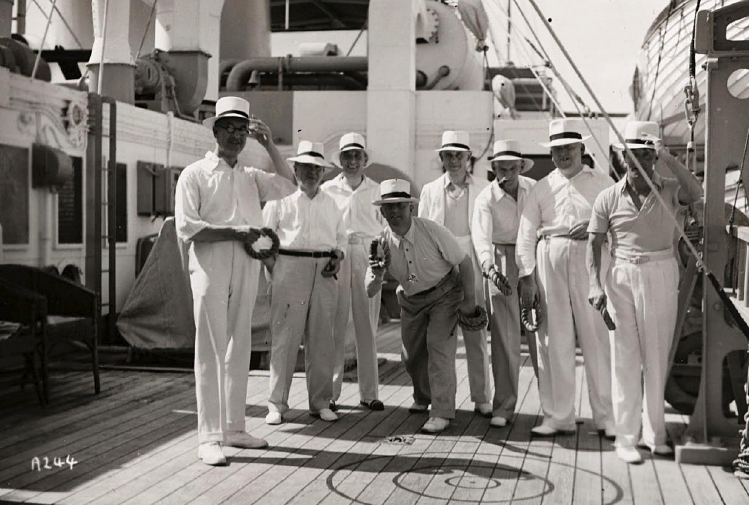 The Atlantic crossing became a social event for those that could afford the trip, with a variety of games and activities offered.
The Atlantic crossing became a social event for those that could afford the trip, with a variety of games and activities offered. -
-
Setting a new standard
The voyages were popular, but life on board was less than charming for poorer passengers. In a sound recording taped late in his life and preserved today at the Emigrant Institute in Växjö, Sweden, John Werner from Cranstown, Rhode Island recalled: “When we traveled to Hull [England] from Göteborg in 1913, there were no plates in third class. They set out a big bowl with soup into which everyone got to dunk pieces of bread. It was a real cattle boat!”
When the British White Star line's "Titanic” delivered more than 1,500 people — including hundreds of Swedes — to a watery grave off Newfoundland's coast in April 1912, authorities as well as passengers began demanding better safety standards and accommodations for everyone on board. It turned out to be the first step in the foundation of SAL.
Around the time of the Titanic tragedy, a Göteborg politician named Wilhelm R. Lundgren, who owned the Transatlantic cargo line, started promoting the idea of a top-quality, Swedish-based passenger ship. Tirelessly crossing both Sweden and the Atlantic, he appeared everywhere from the Swedish Parliament to the settlements of Minnesota, where the Augustana Synod’s pastors supported the concept by recommending purchases of shares at 100 Swedish crowns apiece to their congregations in a bold project that would be called the Swedish America Line.
The exertion of traveling halfway around the world and speaking endlessly to get funding for the project must have exhausted Lundgren, who died before his dream could come true. However, the share capital he managed to amass for SAL passed into the hands of Dan Broström, who served as the administration's minister of marine affairs and whose family had been operating cargo and passenger lines to the U.S. for more than a generation.
Convincing the city of Göteborg to invest an additional one million crowns, Broström purchased from the Holland America Line a vessel recently repaired from WWI mine damage, the "S.S. Potsdam,” and rechristened it the "S.S. Stockholm.” Competitors among Swedish and British passenger lines spread rumors that the ship had been sunk by a German submarine on its maiden voyage and made the most of the infamous sinking of the "Lusitania” only six months before the "Stockholm” was set to sail. But these and other efforts to discredit the company did not deter the launch of SAL.
The first ship left Göteborg on schedule in 1916 under the flag of the mighty Broström shipping concern. It was the groundwork for what would become known as the Swedish America Line nine years later in 1925. Broström died that same year, leaving an enormous legacy. His company’s outstanding success and its positive impact on the city of Göteborg can be measured by the 100,000 local mourners who followed his funeral procession.
The first S.S. Stockholm (there were to be other ships of the same name later) was inaugurated with a party attended by celebrities and dignitaries. Hand-cranked motion picture cameras recorded streams of well-dressed guests, including Swedish Prime Minister Hammarskjöld, along with some 10,000 well-wishers who saw the Stockholm off on its journey.
Waldemar Swahn, a first-class passenger on that maiden journey, wrote in his diary that he could get a bottle of Ramlösa at any hour of the day, and he praised the French dinner menu as a sign of the liner's exceptional class. But in lower classes, signs forbade passengers from taking food from mess halls back to cabins, warned against singing and loud noise, and prohibited ladies’ compartments from being visited (by male passengers, presumably). -
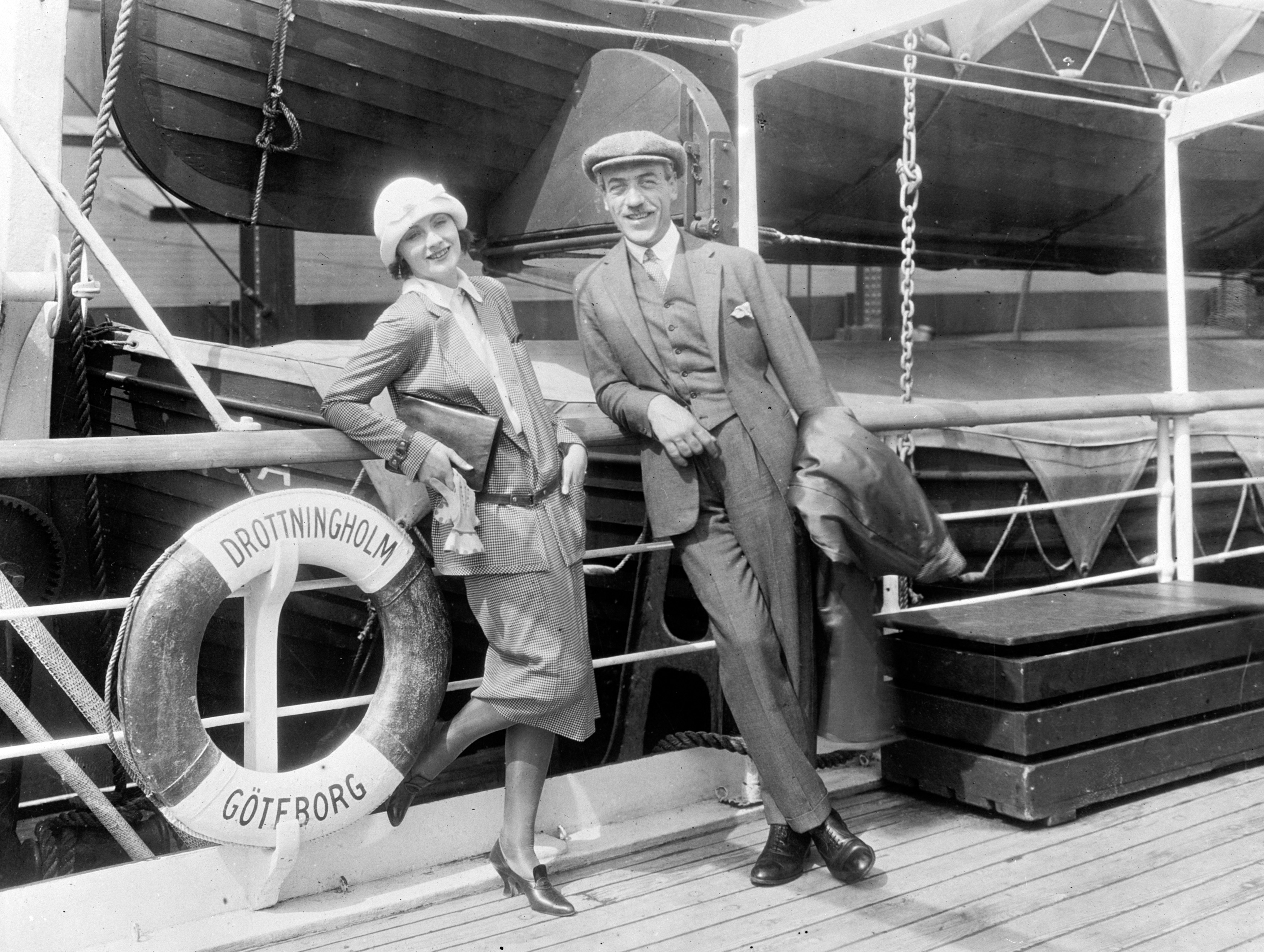 Celebrity travelers, Greta Garbo crossing with Swedish director Mauritz Stiller.
Celebrity travelers, Greta Garbo crossing with Swedish director Mauritz Stiller. -
Luxury between the wars
The heyday for the “Stockholm” and SAL occurred following WWI, when a new wave of some 100,000 Swedes moved to the U.S. to escape food shortages in Sweden. In 1923, strict immigrant quotas were imposed for the first time in the U.S., slowing the emigration business to a standstill. As an attention-getter to revive the seagoing travel business, the city of Göteborg staged a tercentennial anniversary at the high cost of $500,000 to attract American visitors. While the city's treasury suffered, SAL realized good profits and started refreshing their line with new, redecorated versions of the S.S. Gripsholm, S.S. Kungsholm and S.S. Stockholm.
Upon their arrival in America, first-class passengers enjoyed a number of privileges, including bypassing humiliating examinations on Ellis Island and going directly by coach to lavish receptions at New York's finest hotels. But humbler travelers often suffered, sometimes being rejected for health or appearance and deported instantly, detained in squalor for long days, or even dying at the hospital on the island.
Maj Wechselmann, an award-winning Scandinavian documentary filmmaker, made a motion picture on the Swedish America Line. She shared many of her notes for the writing of this article, including the story of her own mother’s immigration to Canada in 1926. Her mother was appalled at the harsh physical trials that Ellis Island health officials forced her to undergo. The journey itself was even worse, and she wrote in her memoirs that she found chloroform to be the best cure for the miserable seasickness that frequently afflicted passengers. Evidently, unconsciousness was preferable to experiencing the miseries of second- and third-class passage.
When Wall Street crashed in 1929, the doors also slammed shut for anyone but the wealthiest and most influential Swedish travelers. Lacking the lucrative business of cross-Atlantic emigrants, SAL President Axel Jönsson conceived a bold new idea that entailed promoting the boats for luxury cruises to Hawaii, Egypt, India, the Galapagos Islands, the Mediterranean and other exotic destinations. With entertainment by greats such as Louis Armstrong and guests such as the Rockefellers, the SAL marketing reorganization was a roaring success. Numerous reels of 16mm film that remain attest to the lavishness of these first-class cruises.
Although there were certainly "VIP” and "Very VIP” sections, everything on these cruises was strictly first class. Interestingly, the marketing maneuver had an additional effect that few appreciated: The odors of the degradation and deprivation of lower-class passages were gone forever. Luxury certainly had its price then as today, but squalor was no longer an alternative for less affluent travelers between Europe and America. -
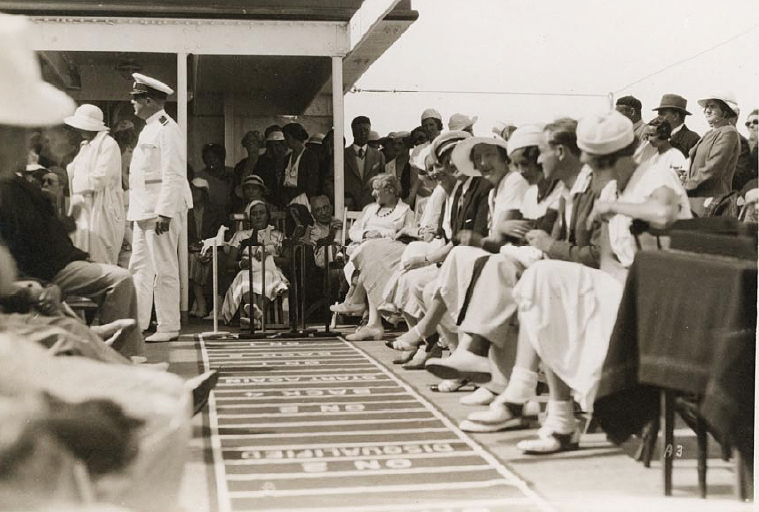 Shuffle board was among the more popular pastimes ...
Shuffle board was among the more popular pastimes ... -
The bridge between Sweden and America
During the period leading up to World War II, Swedes continued to emigrate out of necessity to seek a future in America. At the same time, the ships were their last link with the old country, and this feeling was mirrored in the atmosphere on board during the passage.
On the other hand, these new ships also catered to a more sophisticated group of immigrants, tourists and business people. The nine- to 11-day day crossings now offered plentiful entertainment, dances, movies and gourmet meals. In the mid-1930s, an advertisement for a ship like the S.S. Kungsholm touted its "sumptuous public rooms, distinctive elegance, delightful furnishings and state rooms that make you feel like a king.”
"It is not many years since a voyage across the Atlantic was something in the way of a deterrent,” stated a 1937 booklet about SAL. "But how completely the situation has changed in the last decade. The Swedish America Line has not only been anxious to keep abreast with the times, but it has also in many ways led the way. Its excellent White Fleet has built a bridge between Sweden and America so broad and comfortable that the week spent on it seems all too short to the traveler.”
This was the glamorous age for ocean cruise liners and their passengers. More bookings to Sweden were generated through the Chicago office than anywhere else in the U.S. — so many bookings that SAL was obliged to charter trains with six or seven passenger coaches each to take customers overnight to New York. On the trip, SAL installed staff members on board to cater food and provide Swedish-language newspapers. There was music, dancing and an ambience full of anticipation for the forthcoming adventures, whether incoming or outgoing.
Unquestionably the most lavish ship ever to fly the SAL flag was the third S.S. Stockholm, built in 1948 in Göteborg. Every detail of its planning, construction and launch was documented on film and reported in lengthy newspaper articles on both sides of the Atlantic. Designed to carry 395 passengers and weighing in at 28,000 tons, the third Stockholm was the largest ship ever built at that time at a Swedish shipyard. It was a travel miracle, to press and public alike, and it was appropriately hailed.
Its arrival in New York's harbor after its maiden crossing of the Atlantic prompted a fireworks and water cannon display of mammoth proportions. Its stay in port was one long cocktail party. Sailing at a speedy 21.1 knots during its tenure with Swedish America Line from 1948-1959, the Stockholm was the ultimate mode of post-war European travel. -
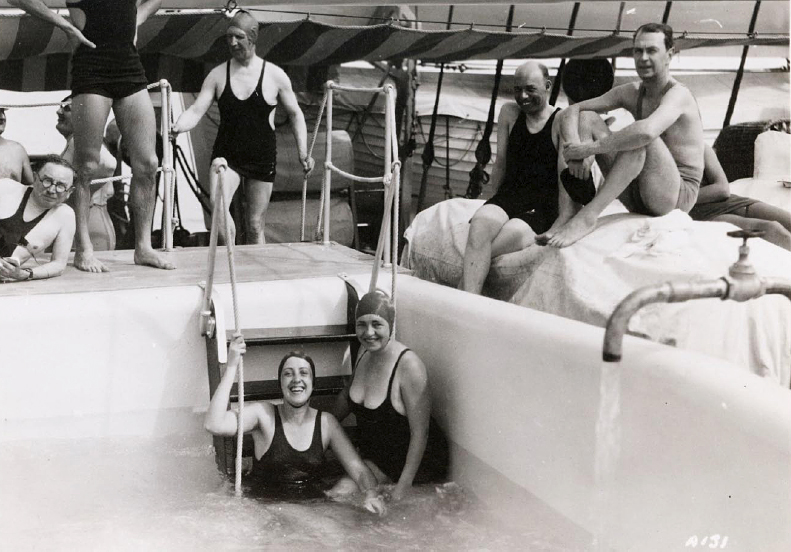 ... as was the pool on deck.
... as was the pool on deck. -
Ulf Barslund Martensson
-
-
